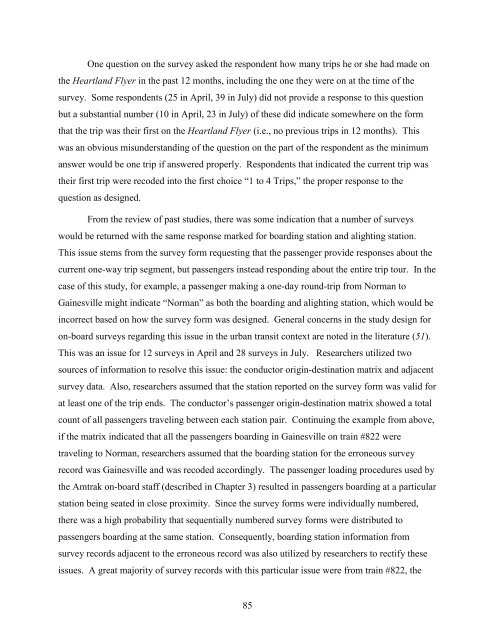Measuring the Benefits of Intercity Passenger Rail: A Study
Measuring the Benefits of Intercity Passenger Rail: A Study
Measuring the Benefits of Intercity Passenger Rail: A Study
Create successful ePaper yourself
Turn your PDF publications into a flip-book with our unique Google optimized e-Paper software.
One question on <strong>the</strong> survey asked <strong>the</strong> respondent how many trips he or she had made on<br />
<strong>the</strong> Heartland Flyer in <strong>the</strong> past 12 months, including <strong>the</strong> one <strong>the</strong>y were on at <strong>the</strong> time <strong>of</strong> <strong>the</strong><br />
survey. Some respondents (25 in April, 39 in July) did not provide a response to this question<br />
but a substantial number (10 in April, 23 in July) <strong>of</strong> <strong>the</strong>se did indicate somewhere on <strong>the</strong> form<br />
that <strong>the</strong> trip was <strong>the</strong>ir first on <strong>the</strong> Heartland Flyer (i.e., no previous trips in 12 months). This<br />
was an obvious misunderstanding <strong>of</strong> <strong>the</strong> question on <strong>the</strong> part <strong>of</strong> <strong>the</strong> respondent as <strong>the</strong> minimum<br />
answer would be one trip if answered properly. Respondents that indicated <strong>the</strong> current trip was<br />
<strong>the</strong>ir first trip were recoded into <strong>the</strong> first choice “1 to 4 Trips,” <strong>the</strong> proper response to <strong>the</strong><br />
question as designed.<br />
From <strong>the</strong> review <strong>of</strong> past studies, <strong>the</strong>re was some indication that a number <strong>of</strong> surveys<br />
would be returned with <strong>the</strong> same response marked for boarding station and alighting station.<br />
This issue stems from <strong>the</strong> survey form requesting that <strong>the</strong> passenger provide responses about <strong>the</strong><br />
current one-way trip segment, but passengers instead responding about <strong>the</strong> entire trip tour. In <strong>the</strong><br />
case <strong>of</strong> this study, for example, a passenger making a one-day round-trip from Norman to<br />
Gainesville might indicate “Norman” as both <strong>the</strong> boarding and alighting station, which would be<br />
incorrect based on how <strong>the</strong> survey form was designed. General concerns in <strong>the</strong> study design for<br />
on-board surveys regarding this issue in <strong>the</strong> urban transit context are noted in <strong>the</strong> literature (51).<br />
This was an issue for 12 surveys in April and 28 surveys in July. Researchers utilized two<br />
sources <strong>of</strong> information to resolve this issue: <strong>the</strong> conductor origin-destination matrix and adjacent<br />
survey data. Also, researchers assumed that <strong>the</strong> station reported on <strong>the</strong> survey form was valid for<br />
at least one <strong>of</strong> <strong>the</strong> trip ends. The conductor’s passenger origin-destination matrix showed a total<br />
count <strong>of</strong> all passengers traveling between each station pair. Continuing <strong>the</strong> example from above,<br />
if <strong>the</strong> matrix indicated that all <strong>the</strong> passengers boarding in Gainesville on train #822 were<br />
traveling to Norman, researchers assumed that <strong>the</strong> boarding station for <strong>the</strong> erroneous survey<br />
record was Gainesville and was recoded accordingly. The passenger loading procedures used by<br />
<strong>the</strong> Amtrak on-board staff (described in Chapter 3) resulted in passengers boarding at a particular<br />
station being seated in close proximity. Since <strong>the</strong> survey forms were individually numbered,<br />
<strong>the</strong>re was a high probability that sequentially numbered survey forms were distributed to<br />
passengers boarding at <strong>the</strong> same station. Consequently, boarding station information from<br />
survey records adjacent to <strong>the</strong> erroneous record was also utilized by researchers to rectify <strong>the</strong>se<br />
issues. A great majority <strong>of</strong> survey records with this particular issue were from train #822, <strong>the</strong><br />
85
















